A Comparative Study of Speech and Silence in Organizational Behavior
VerifiedAdded on 2020/04/07
|8
|2040
|123
Essay
AI Summary
This essay delves into the critical aspects of organizational behavior, specifically examining the significance of communication, speech, and silence within a workplace setting. It begins by highlighting the importance of communication in transmitting thoughts and emotions and how it shapes employee behavior and customer relations. The essay then explores the statement "what you don’t say may be more important than what you do say," dissecting its implications on communication dynamics, including the impact of silence, potential biases, and power dynamics. It identifies workplace problems like communication barriers and the challenges faced by employees. The essay provides recommendations for improving communication, such as frequent group discussions, sign languages for employees with disabilities, and training programs. The essay emphasizes the need for rational thinking and practice to enhance communication skills and foster a positive work environment, ultimately promoting better employee relations and organizational success. The essay concludes by referencing various academic sources to support the arguments presented.
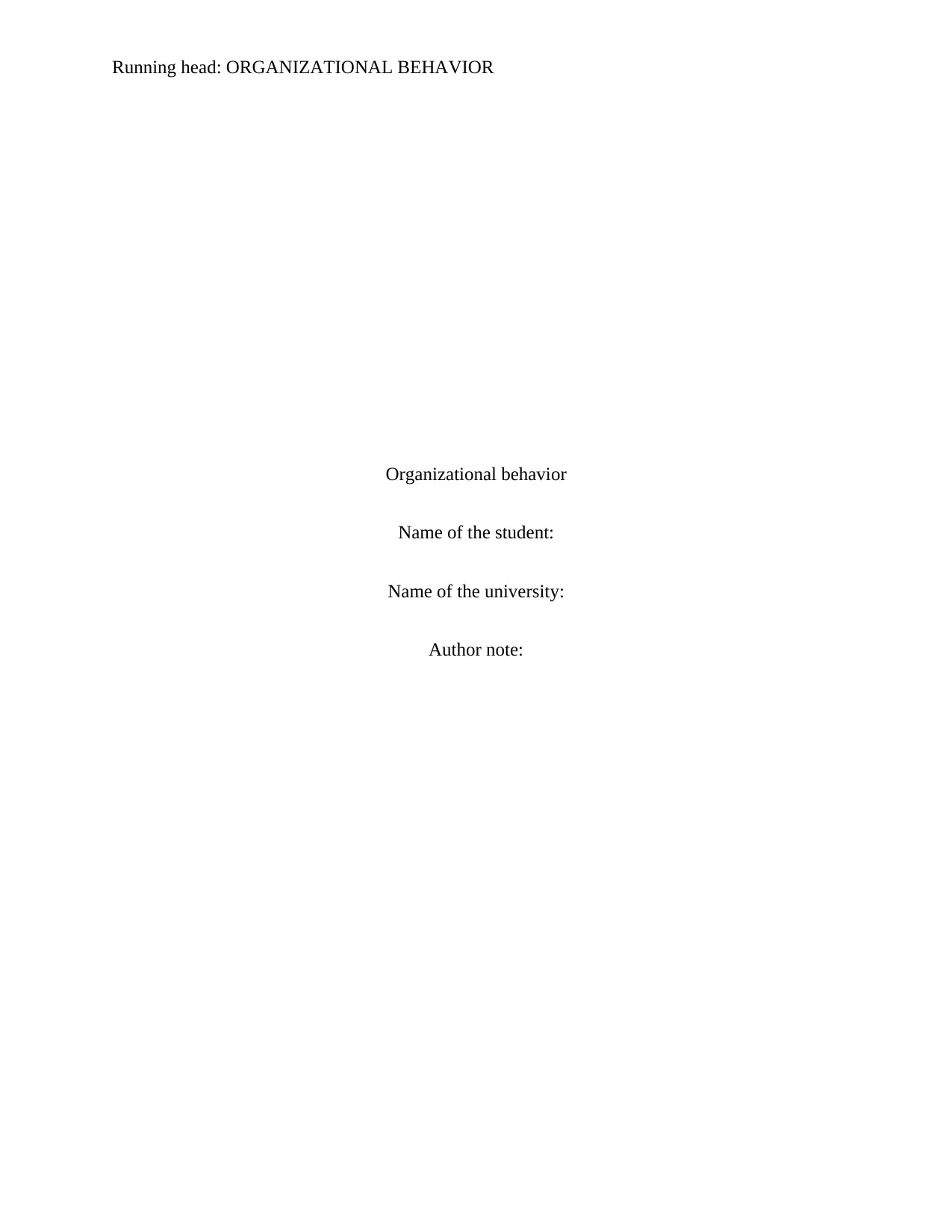
Running head: ORGANIZATIONAL BEHAVIOR
Organizational behavior
Name of the student:
Name of the university:
Author note:
Organizational behavior
Name of the student:
Name of the university:
Author note:
Secure Best Marks with AI Grader
Need help grading? Try our AI Grader for instant feedback on your assignments.
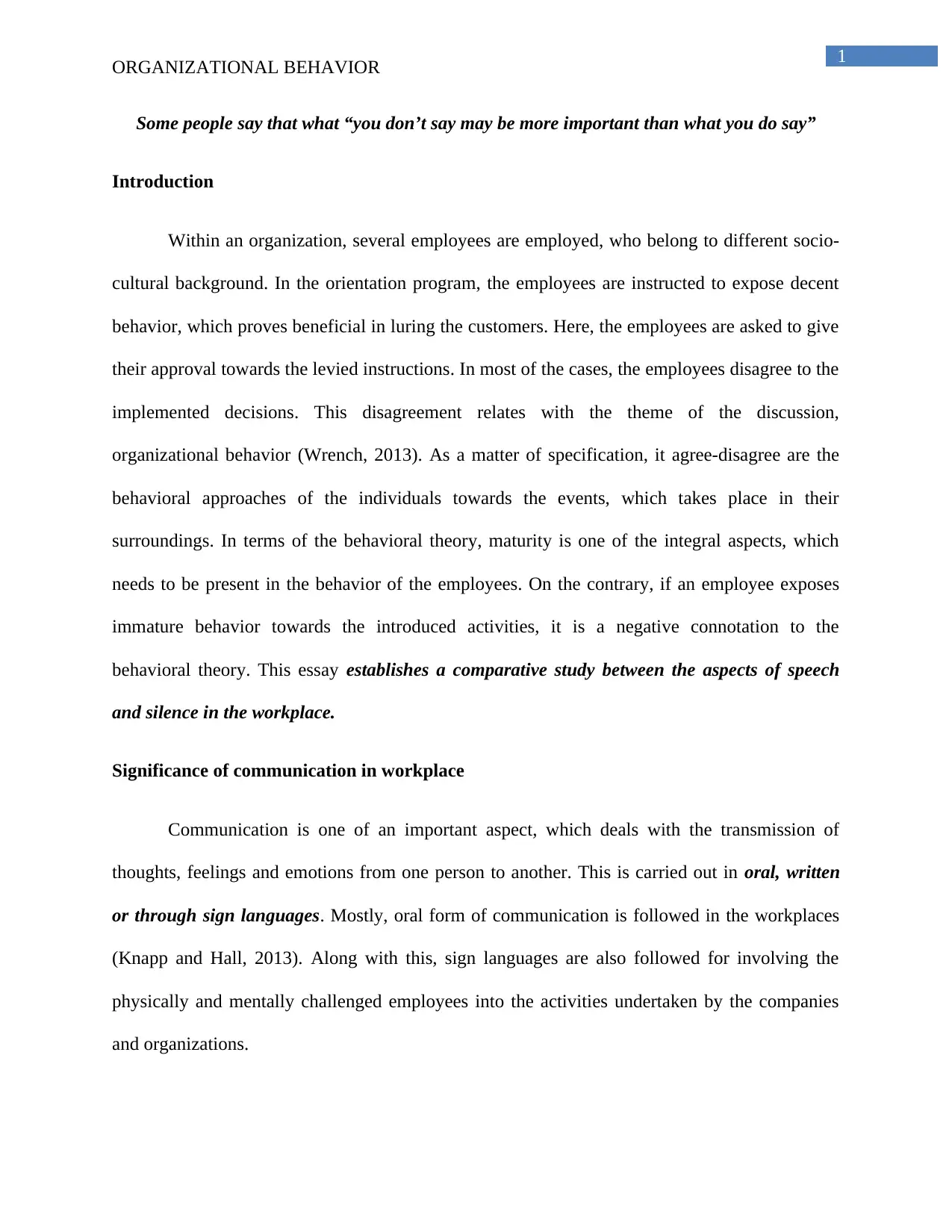
1
ORGANIZATIONAL BEHAVIOR
Some people say that what “you don’t say may be more important than what you do say”
Introduction
Within an organization, several employees are employed, who belong to different socio-
cultural background. In the orientation program, the employees are instructed to expose decent
behavior, which proves beneficial in luring the customers. Here, the employees are asked to give
their approval towards the levied instructions. In most of the cases, the employees disagree to the
implemented decisions. This disagreement relates with the theme of the discussion,
organizational behavior (Wrench, 2013). As a matter of specification, it agree-disagree are the
behavioral approaches of the individuals towards the events, which takes place in their
surroundings. In terms of the behavioral theory, maturity is one of the integral aspects, which
needs to be present in the behavior of the employees. On the contrary, if an employee exposes
immature behavior towards the introduced activities, it is a negative connotation to the
behavioral theory. This essay establishes a comparative study between the aspects of speech
and silence in the workplace.
Significance of communication in workplace
Communication is one of an important aspect, which deals with the transmission of
thoughts, feelings and emotions from one person to another. This is carried out in oral, written
or through sign languages. Mostly, oral form of communication is followed in the workplaces
(Knapp and Hall, 2013). Along with this, sign languages are also followed for involving the
physically and mentally challenged employees into the activities undertaken by the companies
and organizations.
ORGANIZATIONAL BEHAVIOR
Some people say that what “you don’t say may be more important than what you do say”
Introduction
Within an organization, several employees are employed, who belong to different socio-
cultural background. In the orientation program, the employees are instructed to expose decent
behavior, which proves beneficial in luring the customers. Here, the employees are asked to give
their approval towards the levied instructions. In most of the cases, the employees disagree to the
implemented decisions. This disagreement relates with the theme of the discussion,
organizational behavior (Wrench, 2013). As a matter of specification, it agree-disagree are the
behavioral approaches of the individuals towards the events, which takes place in their
surroundings. In terms of the behavioral theory, maturity is one of the integral aspects, which
needs to be present in the behavior of the employees. On the contrary, if an employee exposes
immature behavior towards the introduced activities, it is a negative connotation to the
behavioral theory. This essay establishes a comparative study between the aspects of speech
and silence in the workplace.
Significance of communication in workplace
Communication is one of an important aspect, which deals with the transmission of
thoughts, feelings and emotions from one person to another. This is carried out in oral, written
or through sign languages. Mostly, oral form of communication is followed in the workplaces
(Knapp and Hall, 2013). Along with this, sign languages are also followed for involving the
physically and mentally challenged employees into the activities undertaken by the companies
and organizations.
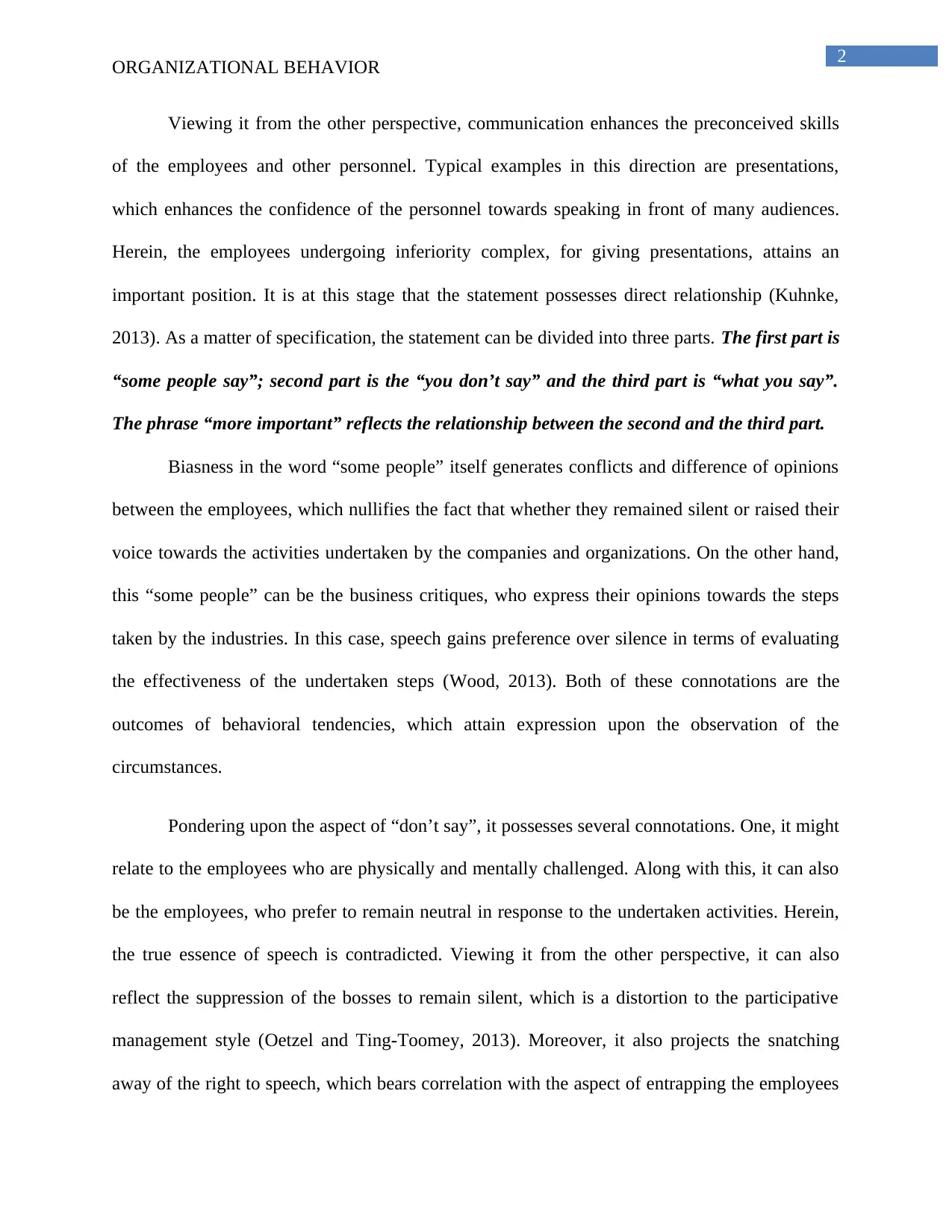
2
ORGANIZATIONAL BEHAVIOR
Viewing it from the other perspective, communication enhances the preconceived skills
of the employees and other personnel. Typical examples in this direction are presentations,
which enhances the confidence of the personnel towards speaking in front of many audiences.
Herein, the employees undergoing inferiority complex, for giving presentations, attains an
important position. It is at this stage that the statement possesses direct relationship (Kuhnke,
2013). As a matter of specification, the statement can be divided into three parts. The first part is
“some people say”; second part is the “you don’t say” and the third part is “what you say”.
The phrase “more important” reflects the relationship between the second and the third part.
Biasness in the word “some people” itself generates conflicts and difference of opinions
between the employees, which nullifies the fact that whether they remained silent or raised their
voice towards the activities undertaken by the companies and organizations. On the other hand,
this “some people” can be the business critiques, who express their opinions towards the steps
taken by the industries. In this case, speech gains preference over silence in terms of evaluating
the effectiveness of the undertaken steps (Wood, 2013). Both of these connotations are the
outcomes of behavioral tendencies, which attain expression upon the observation of the
circumstances.
Pondering upon the aspect of “don’t say”, it possesses several connotations. One, it might
relate to the employees who are physically and mentally challenged. Along with this, it can also
be the employees, who prefer to remain neutral in response to the undertaken activities. Herein,
the true essence of speech is contradicted. Viewing it from the other perspective, it can also
reflect the suppression of the bosses to remain silent, which is a distortion to the participative
management style (Oetzel and Ting-Toomey, 2013). Moreover, it also projects the snatching
away of the right to speech, which bears correlation with the aspect of entrapping the employees
ORGANIZATIONAL BEHAVIOR
Viewing it from the other perspective, communication enhances the preconceived skills
of the employees and other personnel. Typical examples in this direction are presentations,
which enhances the confidence of the personnel towards speaking in front of many audiences.
Herein, the employees undergoing inferiority complex, for giving presentations, attains an
important position. It is at this stage that the statement possesses direct relationship (Kuhnke,
2013). As a matter of specification, the statement can be divided into three parts. The first part is
“some people say”; second part is the “you don’t say” and the third part is “what you say”.
The phrase “more important” reflects the relationship between the second and the third part.
Biasness in the word “some people” itself generates conflicts and difference of opinions
between the employees, which nullifies the fact that whether they remained silent or raised their
voice towards the activities undertaken by the companies and organizations. On the other hand,
this “some people” can be the business critiques, who express their opinions towards the steps
taken by the industries. In this case, speech gains preference over silence in terms of evaluating
the effectiveness of the undertaken steps (Wood, 2013). Both of these connotations are the
outcomes of behavioral tendencies, which attain expression upon the observation of the
circumstances.
Pondering upon the aspect of “don’t say”, it possesses several connotations. One, it might
relate to the employees who are physically and mentally challenged. Along with this, it can also
be the employees, who prefer to remain neutral in response to the undertaken activities. Herein,
the true essence of speech is contradicted. Viewing it from the other perspective, it can also
reflect the suppression of the bosses to remain silent, which is a distortion to the participative
management style (Oetzel and Ting-Toomey, 2013). Moreover, it also projects the snatching
away of the right to speech, which bears correlation with the aspect of entrapping the employees
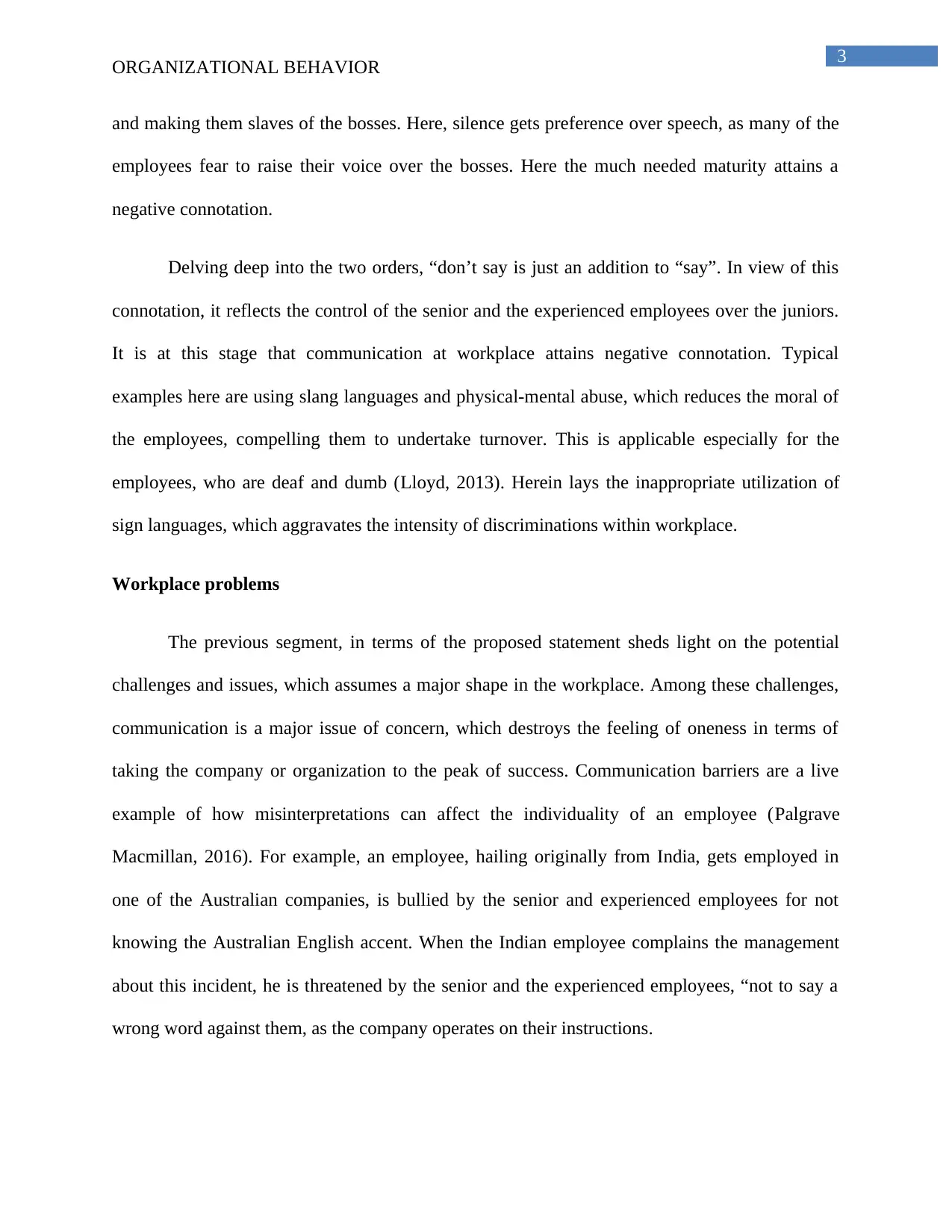
3
ORGANIZATIONAL BEHAVIOR
and making them slaves of the bosses. Here, silence gets preference over speech, as many of the
employees fear to raise their voice over the bosses. Here the much needed maturity attains a
negative connotation.
Delving deep into the two orders, “don’t say is just an addition to “say”. In view of this
connotation, it reflects the control of the senior and the experienced employees over the juniors.
It is at this stage that communication at workplace attains negative connotation. Typical
examples here are using slang languages and physical-mental abuse, which reduces the moral of
the employees, compelling them to undertake turnover. This is applicable especially for the
employees, who are deaf and dumb (Lloyd, 2013). Herein lays the inappropriate utilization of
sign languages, which aggravates the intensity of discriminations within workplace.
Workplace problems
The previous segment, in terms of the proposed statement sheds light on the potential
challenges and issues, which assumes a major shape in the workplace. Among these challenges,
communication is a major issue of concern, which destroys the feeling of oneness in terms of
taking the company or organization to the peak of success. Communication barriers are a live
example of how misinterpretations can affect the individuality of an employee (Palgrave
Macmillan, 2016). For example, an employee, hailing originally from India, gets employed in
one of the Australian companies, is bullied by the senior and experienced employees for not
knowing the Australian English accent. When the Indian employee complains the management
about this incident, he is threatened by the senior and the experienced employees, “not to say a
wrong word against them, as the company operates on their instructions.
ORGANIZATIONAL BEHAVIOR
and making them slaves of the bosses. Here, silence gets preference over speech, as many of the
employees fear to raise their voice over the bosses. Here the much needed maturity attains a
negative connotation.
Delving deep into the two orders, “don’t say is just an addition to “say”. In view of this
connotation, it reflects the control of the senior and the experienced employees over the juniors.
It is at this stage that communication at workplace attains negative connotation. Typical
examples here are using slang languages and physical-mental abuse, which reduces the moral of
the employees, compelling them to undertake turnover. This is applicable especially for the
employees, who are deaf and dumb (Lloyd, 2013). Herein lays the inappropriate utilization of
sign languages, which aggravates the intensity of discriminations within workplace.
Workplace problems
The previous segment, in terms of the proposed statement sheds light on the potential
challenges and issues, which assumes a major shape in the workplace. Among these challenges,
communication is a major issue of concern, which destroys the feeling of oneness in terms of
taking the company or organization to the peak of success. Communication barriers are a live
example of how misinterpretations can affect the individuality of an employee (Palgrave
Macmillan, 2016). For example, an employee, hailing originally from India, gets employed in
one of the Australian companies, is bullied by the senior and experienced employees for not
knowing the Australian English accent. When the Indian employee complains the management
about this incident, he is threatened by the senior and the experienced employees, “not to say a
wrong word against them, as the company operates on their instructions.
Secure Best Marks with AI Grader
Need help grading? Try our AI Grader for instant feedback on your assignments.
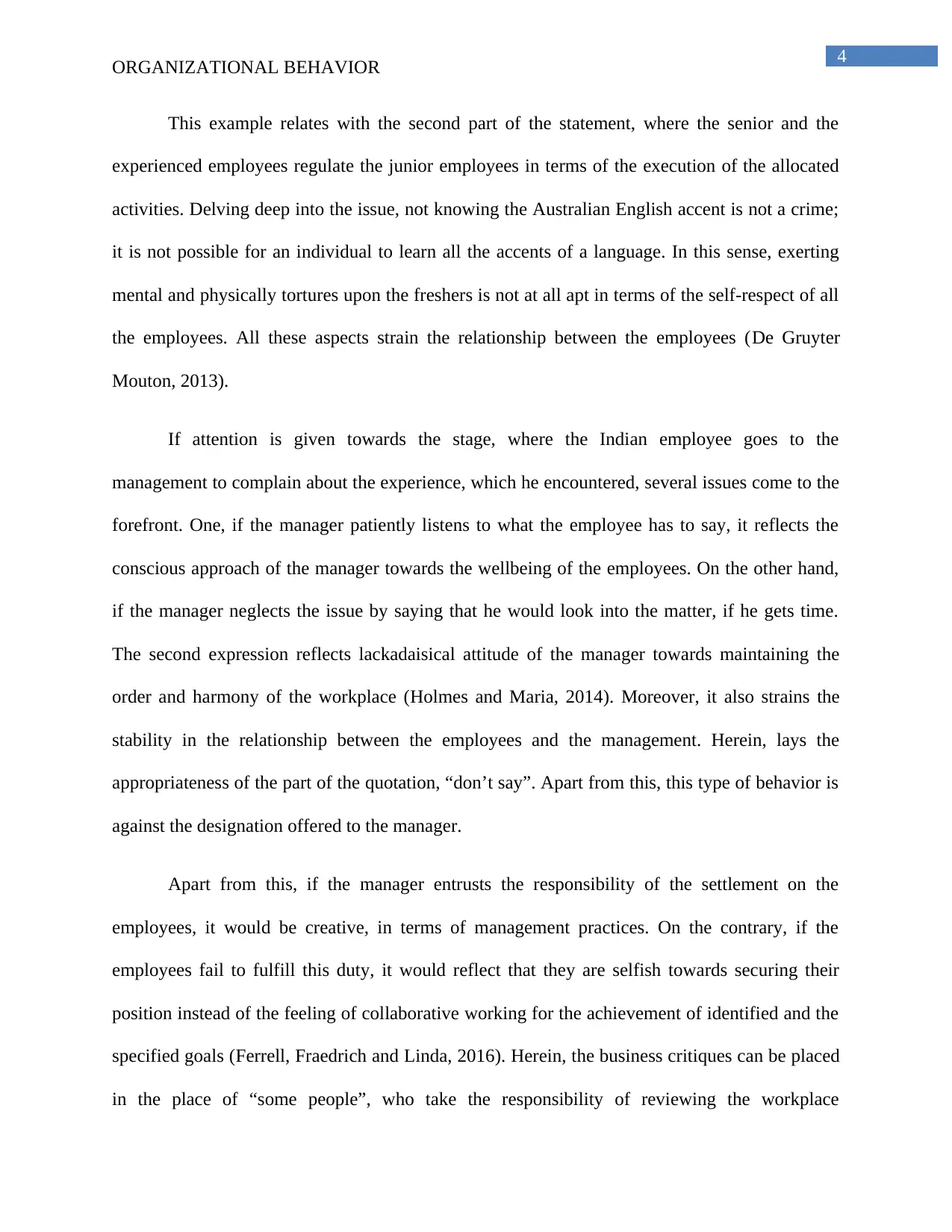
4
ORGANIZATIONAL BEHAVIOR
This example relates with the second part of the statement, where the senior and the
experienced employees regulate the junior employees in terms of the execution of the allocated
activities. Delving deep into the issue, not knowing the Australian English accent is not a crime;
it is not possible for an individual to learn all the accents of a language. In this sense, exerting
mental and physically tortures upon the freshers is not at all apt in terms of the self-respect of all
the employees. All these aspects strain the relationship between the employees (De Gruyter
Mouton, 2013).
If attention is given towards the stage, where the Indian employee goes to the
management to complain about the experience, which he encountered, several issues come to the
forefront. One, if the manager patiently listens to what the employee has to say, it reflects the
conscious approach of the manager towards the wellbeing of the employees. On the other hand,
if the manager neglects the issue by saying that he would look into the matter, if he gets time.
The second expression reflects lackadaisical attitude of the manager towards maintaining the
order and harmony of the workplace (Holmes and Maria, 2014). Moreover, it also strains the
stability in the relationship between the employees and the management. Herein, lays the
appropriateness of the part of the quotation, “don’t say”. Apart from this, this type of behavior is
against the designation offered to the manager.
Apart from this, if the manager entrusts the responsibility of the settlement on the
employees, it would be creative, in terms of management practices. On the contrary, if the
employees fail to fulfill this duty, it would reflect that they are selfish towards securing their
position instead of the feeling of collaborative working for the achievement of identified and the
specified goals (Ferrell, Fraedrich and Linda, 2016). Herein, the business critiques can be placed
in the place of “some people”, who take the responsibility of reviewing the workplace
ORGANIZATIONAL BEHAVIOR
This example relates with the second part of the statement, where the senior and the
experienced employees regulate the junior employees in terms of the execution of the allocated
activities. Delving deep into the issue, not knowing the Australian English accent is not a crime;
it is not possible for an individual to learn all the accents of a language. In this sense, exerting
mental and physically tortures upon the freshers is not at all apt in terms of the self-respect of all
the employees. All these aspects strain the relationship between the employees (De Gruyter
Mouton, 2013).
If attention is given towards the stage, where the Indian employee goes to the
management to complain about the experience, which he encountered, several issues come to the
forefront. One, if the manager patiently listens to what the employee has to say, it reflects the
conscious approach of the manager towards the wellbeing of the employees. On the other hand,
if the manager neglects the issue by saying that he would look into the matter, if he gets time.
The second expression reflects lackadaisical attitude of the manager towards maintaining the
order and harmony of the workplace (Holmes and Maria, 2014). Moreover, it also strains the
stability in the relationship between the employees and the management. Herein, lays the
appropriateness of the part of the quotation, “don’t say”. Apart from this, this type of behavior is
against the designation offered to the manager.
Apart from this, if the manager entrusts the responsibility of the settlement on the
employees, it would be creative, in terms of management practices. On the contrary, if the
employees fail to fulfill this duty, it would reflect that they are selfish towards securing their
position instead of the feeling of collaborative working for the achievement of identified and the
specified goals (Ferrell, Fraedrich and Linda, 2016). Herein, the business critiques can be placed
in the place of “some people”, who take the responsibility of reviewing the workplace
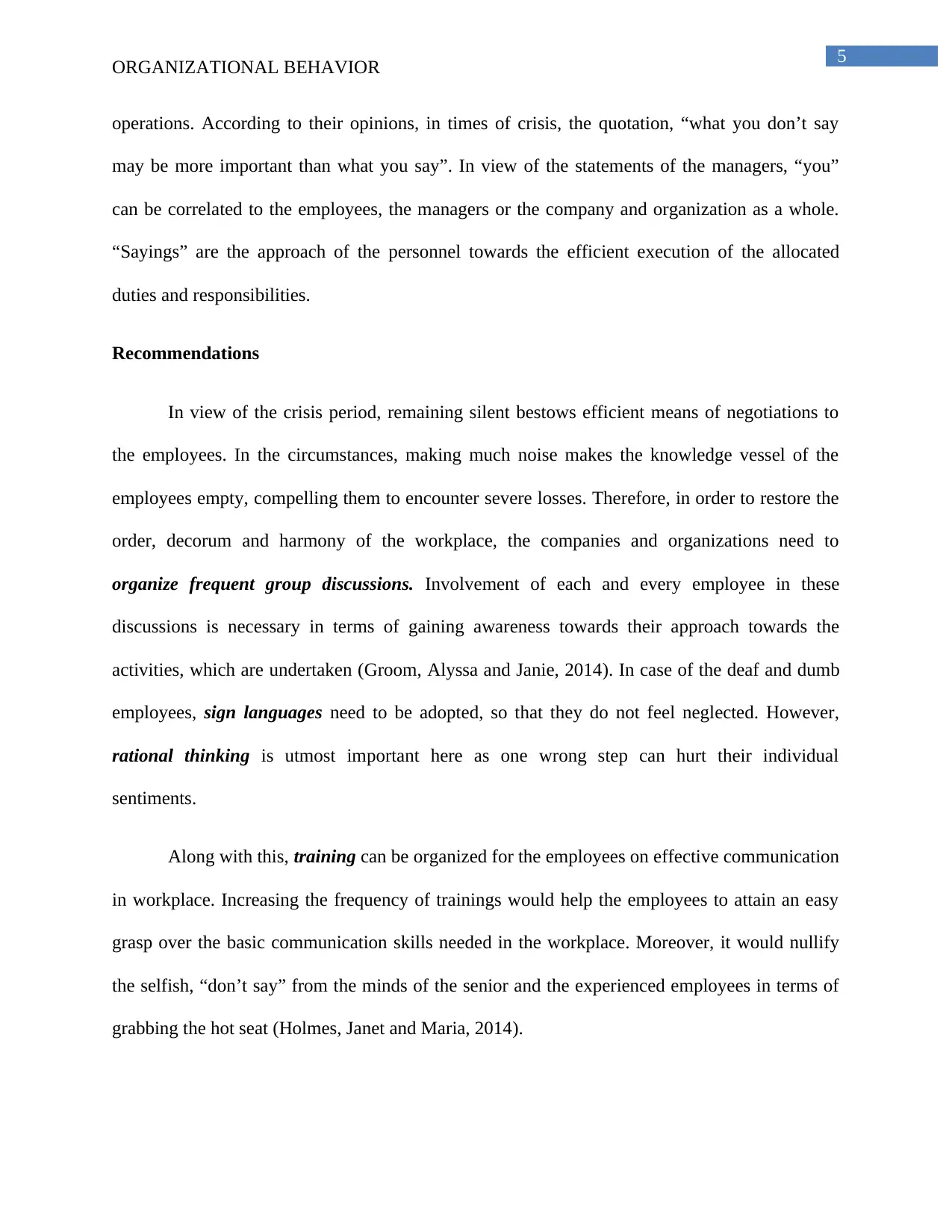
5
ORGANIZATIONAL BEHAVIOR
operations. According to their opinions, in times of crisis, the quotation, “what you don’t say
may be more important than what you say”. In view of the statements of the managers, “you”
can be correlated to the employees, the managers or the company and organization as a whole.
“Sayings” are the approach of the personnel towards the efficient execution of the allocated
duties and responsibilities.
Recommendations
In view of the crisis period, remaining silent bestows efficient means of negotiations to
the employees. In the circumstances, making much noise makes the knowledge vessel of the
employees empty, compelling them to encounter severe losses. Therefore, in order to restore the
order, decorum and harmony of the workplace, the companies and organizations need to
organize frequent group discussions. Involvement of each and every employee in these
discussions is necessary in terms of gaining awareness towards their approach towards the
activities, which are undertaken (Groom, Alyssa and Janie, 2014). In case of the deaf and dumb
employees, sign languages need to be adopted, so that they do not feel neglected. However,
rational thinking is utmost important here as one wrong step can hurt their individual
sentiments.
Along with this, training can be organized for the employees on effective communication
in workplace. Increasing the frequency of trainings would help the employees to attain an easy
grasp over the basic communication skills needed in the workplace. Moreover, it would nullify
the selfish, “don’t say” from the minds of the senior and the experienced employees in terms of
grabbing the hot seat (Holmes, Janet and Maria, 2014).
ORGANIZATIONAL BEHAVIOR
operations. According to their opinions, in times of crisis, the quotation, “what you don’t say
may be more important than what you say”. In view of the statements of the managers, “you”
can be correlated to the employees, the managers or the company and organization as a whole.
“Sayings” are the approach of the personnel towards the efficient execution of the allocated
duties and responsibilities.
Recommendations
In view of the crisis period, remaining silent bestows efficient means of negotiations to
the employees. In the circumstances, making much noise makes the knowledge vessel of the
employees empty, compelling them to encounter severe losses. Therefore, in order to restore the
order, decorum and harmony of the workplace, the companies and organizations need to
organize frequent group discussions. Involvement of each and every employee in these
discussions is necessary in terms of gaining awareness towards their approach towards the
activities, which are undertaken (Groom, Alyssa and Janie, 2014). In case of the deaf and dumb
employees, sign languages need to be adopted, so that they do not feel neglected. However,
rational thinking is utmost important here as one wrong step can hurt their individual
sentiments.
Along with this, training can be organized for the employees on effective communication
in workplace. Increasing the frequency of trainings would help the employees to attain an easy
grasp over the basic communication skills needed in the workplace. Moreover, it would nullify
the selfish, “don’t say” from the minds of the senior and the experienced employees in terms of
grabbing the hot seat (Holmes, Janet and Maria, 2014).
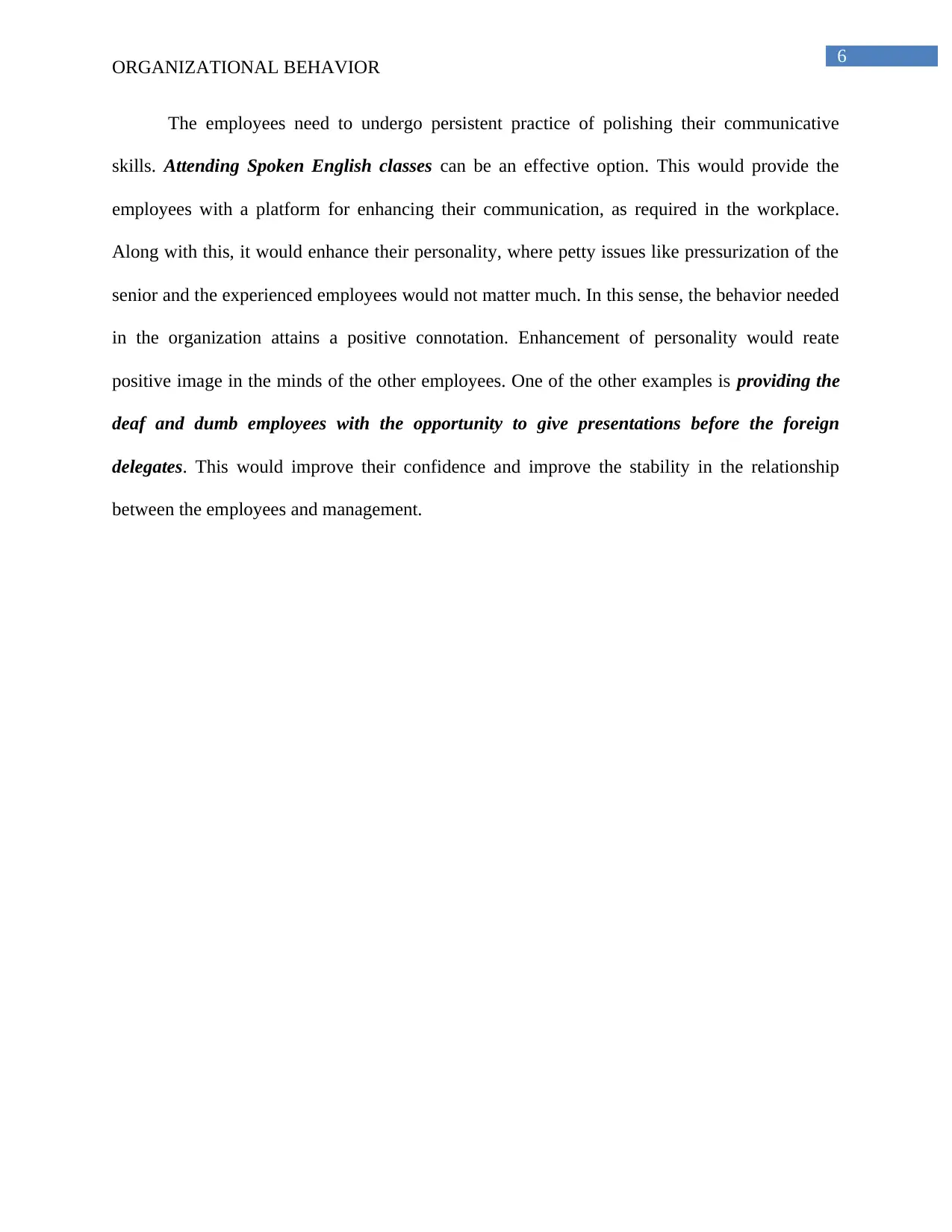
6
ORGANIZATIONAL BEHAVIOR
The employees need to undergo persistent practice of polishing their communicative
skills. Attending Spoken English classes can be an effective option. This would provide the
employees with a platform for enhancing their communication, as required in the workplace.
Along with this, it would enhance their personality, where petty issues like pressurization of the
senior and the experienced employees would not matter much. In this sense, the behavior needed
in the organization attains a positive connotation. Enhancement of personality would reate
positive image in the minds of the other employees. One of the other examples is providing the
deaf and dumb employees with the opportunity to give presentations before the foreign
delegates. This would improve their confidence and improve the stability in the relationship
between the employees and management.
ORGANIZATIONAL BEHAVIOR
The employees need to undergo persistent practice of polishing their communicative
skills. Attending Spoken English classes can be an effective option. This would provide the
employees with a platform for enhancing their communication, as required in the workplace.
Along with this, it would enhance their personality, where petty issues like pressurization of the
senior and the experienced employees would not matter much. In this sense, the behavior needed
in the organization attains a positive connotation. Enhancement of personality would reate
positive image in the minds of the other employees. One of the other examples is providing the
deaf and dumb employees with the opportunity to give presentations before the foreign
delegates. This would improve their confidence and improve the stability in the relationship
between the employees and management.
Paraphrase This Document
Need a fresh take? Get an instant paraphrase of this document with our AI Paraphraser
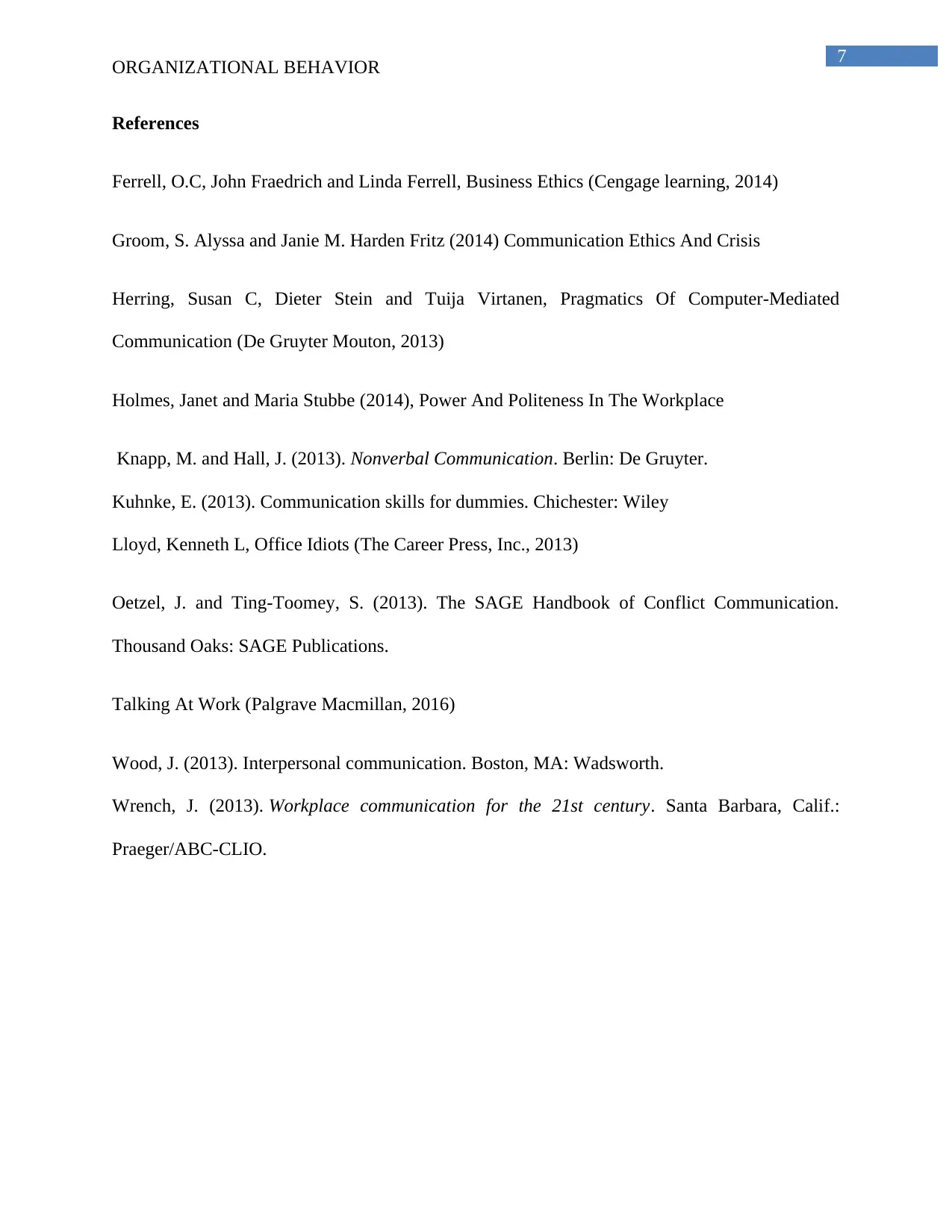
7
ORGANIZATIONAL BEHAVIOR
References
Ferrell, O.C, John Fraedrich and Linda Ferrell, Business Ethics (Cengage learning, 2014)
Groom, S. Alyssa and Janie M. Harden Fritz (2014) Communication Ethics And Crisis
Herring, Susan C, Dieter Stein and Tuija Virtanen, Pragmatics Of Computer-Mediated
Communication (De Gruyter Mouton, 2013)
Holmes, Janet and Maria Stubbe (2014), Power And Politeness In The Workplace
Knapp, M. and Hall, J. (2013). Nonverbal Communication. Berlin: De Gruyter.
Kuhnke, E. (2013). Communication skills for dummies. Chichester: Wiley
Lloyd, Kenneth L, Office Idiots (The Career Press, Inc., 2013)
Oetzel, J. and Ting-Toomey, S. (2013). The SAGE Handbook of Conflict Communication.
Thousand Oaks: SAGE Publications.
Talking At Work (Palgrave Macmillan, 2016)
Wood, J. (2013). Interpersonal communication. Boston, MA: Wadsworth.
Wrench, J. (2013). Workplace communication for the 21st century. Santa Barbara, Calif.:
Praeger/ABC-CLIO.
ORGANIZATIONAL BEHAVIOR
References
Ferrell, O.C, John Fraedrich and Linda Ferrell, Business Ethics (Cengage learning, 2014)
Groom, S. Alyssa and Janie M. Harden Fritz (2014) Communication Ethics And Crisis
Herring, Susan C, Dieter Stein and Tuija Virtanen, Pragmatics Of Computer-Mediated
Communication (De Gruyter Mouton, 2013)
Holmes, Janet and Maria Stubbe (2014), Power And Politeness In The Workplace
Knapp, M. and Hall, J. (2013). Nonverbal Communication. Berlin: De Gruyter.
Kuhnke, E. (2013). Communication skills for dummies. Chichester: Wiley
Lloyd, Kenneth L, Office Idiots (The Career Press, Inc., 2013)
Oetzel, J. and Ting-Toomey, S. (2013). The SAGE Handbook of Conflict Communication.
Thousand Oaks: SAGE Publications.
Talking At Work (Palgrave Macmillan, 2016)
Wood, J. (2013). Interpersonal communication. Boston, MA: Wadsworth.
Wrench, J. (2013). Workplace communication for the 21st century. Santa Barbara, Calif.:
Praeger/ABC-CLIO.
1 out of 8
Your All-in-One AI-Powered Toolkit for Academic Success.
+13062052269
info@desklib.com
Available 24*7 on WhatsApp / Email
![[object Object]](/_next/static/media/star-bottom.7253800d.svg)
Unlock your academic potential
© 2024 | Zucol Services PVT LTD | All rights reserved.


